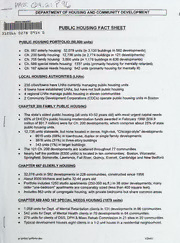
Public housing fact sheet PDF
Preview Public housing fact sheet
1 f%? W\^\ CpiLSL: DEPARTMENT OF HOUSING AND COMMUNITY DEVELOPMENT PUBLIC HOUSING FACT SHEET mm 3120bb 0S7fl D PUBLIC HOUSING PORTFOLIO (50.000 units) Ch. 667 elderly housing: 32,078 units (in 3,120 buildings in 582 developments) Ch. 200 family housing: 12,736 units (in 2,774 buildings in 121 developments) Ch. 705 family housing: 3,000 units (in 1,178 buildings in 636 developments) Ch. 689 special needs housing: 1337 units (primarily housing for mentally retarded) Ch. 167 special needs housing: 542 units (primarily housing for mentally ill) LOCAL HOUSING AUTHORITIES (LHAs) • 235 cities/towns have LHAs currently managing public housing units • 8 towns have established LHAs, but have not built public housing • 4 regional LHAs manage public housing in eleven communities • 2 Community Development Corporations (CDCs) operate public housing units in Boston CHAPTER 200 FAMILY PUBLIC HOUSING • The state's oldest public housing (all units 43-52 years old) with most urgent capital needs • 65% of DHCD's public housing modernization funds awarded in February 1999 ($59.9 million of $91.7 million) were for Ch. 200 developments, which comprise about 25% of state public housing units. • 12,736 units statewide, but none located in dense, high-rise, "Chicago-style" developments • 8615 units (68%) in townhouse, duplex or single family developments • 3978 units (31%) in three-story buildings • 143 units (1%) in larger buildings • The 121 Ch. 200 developments are scattered throughout 77 communities • Nearly halfthe portfolio (6300 units) is located in ten communities: Boston, Worcester, Springfield, Somerville, Lawrence, Fall River, Quincy, Everett, Cambridge and New Bedford CHAPTER 667 ELDERLY HOUSING • 32,078 units in 582 developments in 228 communities, constructed since 1956 • About 8500 kitchens and baths 32-44 years old • Portfolio includes 1250 studio apartments (250-350 sq.ft.) in 38 older developments; many older "one-bedroom" apartments are comparably sized (less than 400 square feet). • Includes 863 units of congregate housing, with private bedrooms but share common areas. CHAPTER 689 AND 167 SPECIAL NEEDS HOUSING (1879 units) • 1 ,058 units for Dept. of Mental Retardation clients in 131 developments in 96 communities. • 542 units for Dept. of Mental Health clients in 70 developments in 64 communities. • 279 units for clients of DSS, DPH & Mass Rehab Commission in 21 sites in 20 communities. • Typical development houses eight clients in a 1-2 unit house in a residential neighborhood. p:\policy\prtfolio.doc 1/26/0 . 1 Department of Housing and Community Development FACTSHEET: CHAPTER 200 FAMILY PUBLIC HOUSING 12,736 total units, built between 1948 and 1956 • 8615 units in townhouses, duplexes or single family homes • 3978 units in three-story buildings • 143 units in buildings four stories or taller (two developments) 121 total developments in 77 communities • 19 developments with 200 or more units house 43% of all Ch. 200 units (5447 units) • 46 developments with 100 or more units house 72% of all Ch. 200 units (9170 units) • 75 developments have less than 100 units each (3566 units) Of the 19 developments with 200 or more units, only 1 developments have 5 or more units per building Of the 46 developments with 100 or more units, only 25 developments have 5 or more units per building Almost half of the total portfolio (6,300 units) is in 10 communities: Boston, Worcester, Springfield, Somerville, Lawrence, Fair River, Quincy, Everett, Cambridge and New Bedford p:/policy/ch200/factsht 1/24/01 w
